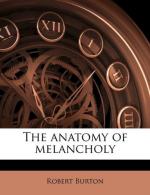That [738]lovers are mad, I think no man will deny, Amare simul et sapere, ipsi Jovi non datur, Jupiter himself cannot intend both at once.
[739] “Non bene conveniunt, nec in una sede
morantur
Majestas
et amor.”
Tully, when he was invited to a second marriage, replied, he could not simul amare et sapere be wise and love both together. [740]_Est orcus ille, vis est immedicabilis, est rabies insana_, love is madness, a hell, an incurable disease; inpotentem et insanam libidinem [741]Seneca calls it, an impotent and raging lust. I shall dilate this subject apart; in the meantime let lovers sigh out the rest.
[742]Nevisanus the lawyer holds it for an axiom, “most women are fools,” [743]_consilium foeminis invalidum_; Seneca, men, be they young or old; who doubts it, youth is mad as Elius in Tully, Stulti adolescentuli, old age little better, deleri senes, &c. Theophrastes, in the 107th year of his age, [744]said he then began to be to wise, tum sapere coepit, and therefore lamented his departure. If wisdom come so late, where shall we find a wise man? Our old ones dote at threescore-and-ten. I would cite more proofs, and a better author, but for the present, let one fool point at another. [745]Nevisanus hath as hard an opinion of [746]rich men, “wealth and wisdom cannot dwell together,” stultitiam patiuntur opes, [747]and they do commonly [748]_infatuare cor hominis_, besot men; and as we see it, “fools have fortune:” [749]_Sapientia non invenitur in terra suaviter viventium_. For beside a natural contempt of learning, which accompanies such kind of men, innate idleness (for they will take no pains), and which [750]Aristotle observes, ubi mens plurima, ibi minima fortuna, ubi plurima fortuna, ibi mens perexigua, great wealth and little wit go commonly together: they have as much brains some of them in their heads as in their heels; besides this inbred neglect of liberal sciences, and all arts, which should excolere mentem, polish the mind, they have most part some gullish humour or other, by which they are led; one is an Epicure, an Atheist, a second a gamester, a third a whoremaster (fit subjects all for a satirist to work upon);




